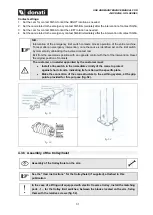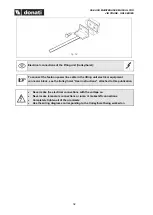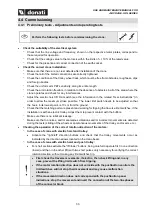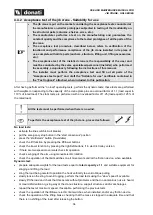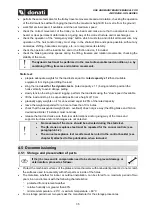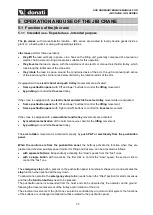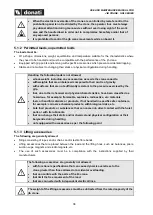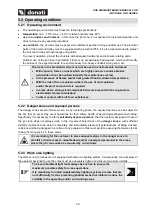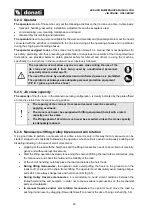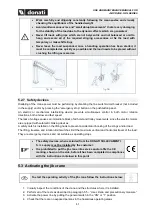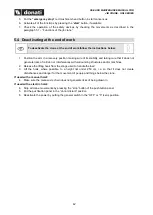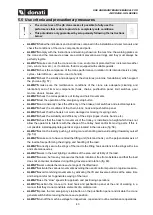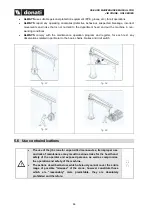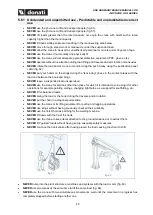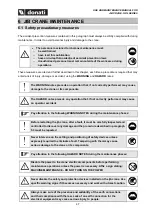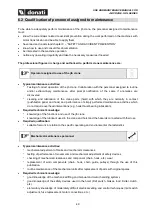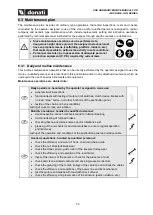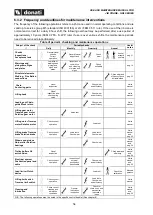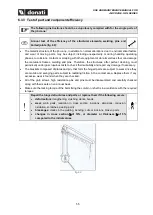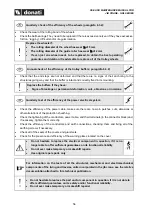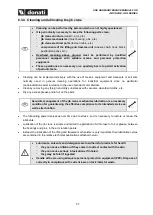
USE AND MAINTENANCE MANUAL FOR
JIB CRANE
-
GRL SERIES
43
5.5 Use criteria and precautionary measures
•
The correct use of the jib crane makes it possible to fully use the
performance that is able to provide in completely safe conditions.
•
This potential is only guaranteed by scrupulously following the instructions
below:
•
ALWAYS
follow the indications and instructions contained in the installation and user manuals and
check the conditions of the crane components and parts.
•
ALWAYS
comply with the instructions and warning shown on the machine; the warning plates on
the crane and the manoeuvre areas are accident prevention warnings and they must always be
perfectly legible.
•
ALWAYS
make sure that the crane works in an environment protected from inclement weather
(rain, wind, snow, etc.) or, if outdoors, that it is equipped with suitable guards.
•
ALWAYS
check the compliance of the crane performance in relation to its intended service (duty
cycles - intermittence - use time - load to handle) .
•
ALWAYS
check the solidity and adequacy of the structures (columns, foundations) which support
the jib crane (fig. 57).
•
ALWAYS
make sure the maintenance conditions of the crane are adequate (cleaning and
lubrication) and of its main components (hook, chains, pushbutton panel, limit switches, gear
motors, wheels, brakes, etc.).
•
ALWAYS
check the correspondence of trolley and hoist movements.
•
ALWAYS
test the operation of the emergency stop button.
•
ALWAYS
and constantly check the efficiency of the brakes, limit switches and electrical system.
•
ALWAYS
check the conditions of the chain, block, hook and pushbutton panel.
•
ALWAYS
check that the hook is not worn, damaged or missing its spring catch.
•
ALWAYS
check the suitability and efficiency of the slings (ropes, chains, bands, etc.).
•
ALWAYS
check that the track for movement of the trolley, is installed at a height which does not
allow the operator to interfere with the shape of the trolley hoist and/or its moving parts. If this is
not possible install appropriate guards or signs located in the risk area (fig. 58).
•
ALWAYS
act on the load by pushing it during manual handling and avoid pulling it towards yourself
•
ALWAYS
make sure to have centred the lifting unit (hoist and hook), on the perpendicular axis of
the load before performing the slinging and handling of the load.
•
ALWAYS
correctly secure the slings of the load to the lifting hook and tension the slings with slow
and safe manoeuvres.
•
ALWAYS
work in the best lighting conditions of the area and visibility of the load.
•
ALWAYS
ensure, before any manoeuvres that arm rotation is free from obstacles and that the load
does not encounter obstacles during lifting, traverse and rotation
•
ALWAYS
work outside the manoeuvre range of the lifted load.
•
ALWAYS
activate the various movements avoiding the use of control impulses in rapid succession.
•
ALWAYS
avoid combining movements by activating the lift and traverse buttons at the same time
and being careful not to generate swaying of the load.
•
ALWAYS
use the “slow” speeds for approach and positioning operations.
•
ALWAYS
position the crane arm, load hook and pushbutton panel at the end of working in a
manner that they do not constitute elements of a collision risk.
•
ALWAYS
press the red emergency stop button on the pushbutton panel and disable the crane
general switch before leaving the manoeuvre position.
•
ALWAYS
turn off the machine voltage for inspections, repairs and routine maintenance operations.
Summary of Contents for GRL Series
Page 2: ......
Page 14: ...USE AND MAINTENANCE MANUAL FOR JIB CRANE GRL SERIES 10 Fixing systems for jib cranes ...
Page 64: ......



